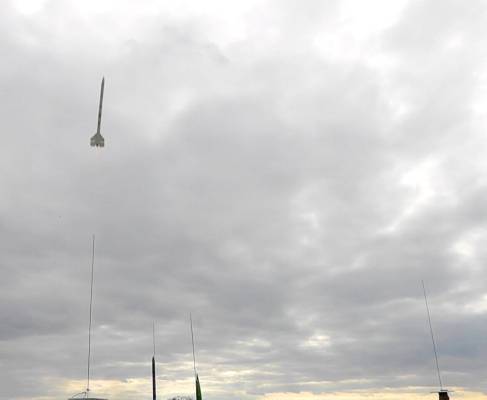The Beta: I love this little gem, but I haven't been able to get T sized booster motors any more.
UPDATE: Estes is now making them again - I have some due to arrive shortly! Yea!!!!!
I think the small size of this rocket combined with its high-altitude capabilities is better off with a bright Mylar streamer instead of the 10" parachute. This makes it easier to spot in the air and on the ground, and reduces drifting in the wind. This rocket was recently given my "Iris" modification, which extends the body tube about 5 inches above the streamer/parachute bay, and allows for a payload with an Altimeter One to measure altitudes. The A-power booster and A-power sustainer really lift this Beta high, over 700 feet on just two A's! I'd say that's pretty good proof that multi-stage rockets are more efficient with propellant, as the same mass of propellant made into a single B-motor would have topped-out at about 500 feet.
After a flight where the second stage did not light for unknown reasons, the Beta was badly damaged. It was repaired with a new and shorter payload section, and the body tube was lengthened to fix the worn-down top of the tube. This rocket is now 19-7/8" long with both stages.
What's great about this kit is you can fly a two stage very economically, since T motors are cheaper than standard sizes. (Iris is named after the Greek god of the rainbow. She is a messenger of the gods, linking the gods with humanity.) This rocket has flown higher than the Revel Casino Towers in Atlantic City, and the Met-Life Tower in NY, and could very easily fly over the St. Louis Gateway Arch.
| Flight Date: | 2012-11-04 |
| Rocket Name: | Beta |
| Kit Name: | Estes - Beta {Kit} (845) [1972-1984] |
| Flyer's Name: | Rich DeAngelis |
| Motors: | A10-0/A3-4 |
| Expected Altitude: | 700 Feet |
| Wind Speed: | 14.00 mph |
| Launch Site: | Penn Manor School Lancaster PA |
| Actual Altitude: | 515 Feet |
This is the third attempt to get data on the A-to-A powered two stage flight. The strong winds may have caused a launch abort, but I knew this rocket can accelerate quickly and avoid the winds. Still, it was very windy and there was a degree of risk.
The launch was good and at about 200 feet the second stage lit (thank God, I wasn’t about to repair it a fourth time!). Because of the strong wind, the staging was at about a 20 degree angle into the wind, which certainly affected the altitude. The second stage continued upwind quickly at about 30 degrees from vertical so that the apogee was probably about 200-300 feet upwind, across the road and into the upwind field.
The maximum speed was measured at 124 mph, and the 1.1 second burn produced an average acceleration of 5.1 Gs, with a peak of 17.6 Gs (presumably from the first stage). It coasted for 5.2 seconds which was a long delay for the A3-4 sustainer, but that allowed it to continue climbing, with the ejection at 451 feet, still climbing, it reached an apogee of 515 feet.
At the apogee the fully deployed Mylar streamer took over and then the Beta descended back to the ground at a soft, 13 mph. Finally I have some flight data for the 2-stage Beta Iris!
During the descent it drifted a lot, but that caused it to return to the launch area about 50 feet from the launch pad. The booster was recovered about 50 feet downwind. Total flight time was 28.1 seconds.
This was a good flight, and although the shock cord and leader of the streamer twisted together it was not enough to keep the streamer from unrolling and being effective.
Post flight inspection showed the payload tube was split along the spiral from the bulkhead and up about ½ inch. I’m not sure why it was damaged because it landed slowly and in grass. It will be an easy fix though, and another scar on this battle-tested rocket.
| Stage | Motor(s) |
|---|---|
| 1 | Estes A10T-0 |
 |
 |


